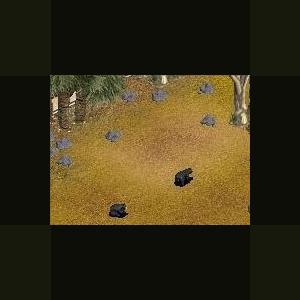About This File
Tasmanian devils are fierce carnivorous marsupials that typically live alone.
Geographic Range
Currently Sarcophilus laniarius is found only in Tasmania, although fossil evidence suggests that it once occupied much of the Australian mainland. It has been suggested that its absence in many previously occupied areas can be explained by competition with the introduced dingo in Australia. (Nowak, 1991)
Habitat
Tasmanian devils are numerous throughout Tasmania except in areas where there has been extensive habitat fragmentation and deforestation. They are most numerous in coastal heath and rangeland areas where agricultural practices maintain a constant supply of carrion. They also occur in open, dry schlerophyll forest and mixed schlerophyll rainforest. Their dens typically are located in hollow logs, caves, or burrows. (DPIWE and Nature Conservation Branch, 2005; Nowak, 1991)
Physical Description
Mass
4 to 12 kg
(8.8 to 26.4 lbs)
Length
525 to 800 mm
(20.67 to 31.5 in)
Tasmanian devils are stocky with a brownish black pelage. They have a white throat patch, white spots on their sides and backside, and a pinkish snout. The head is massive with well developed jaw muscles. Molar teeth are heavy and adapted for their role in crushing bone and tearing through muscle and thick skin. Females are slightly smaller than males. Body size varies considerably with diet, habitat, and age. Large males may reach 12 kg and 30 cm at the shoulder. Total length ranges from 525 to 800 mm and tail length from 230-300 mm. Male weight ranges from 5.5 to 12 kg and female weight from 4.1 to 8.1 kg. Fat storage occurs in the tail, as in many dasyurids. Females have four mammae and, unlike many other dasyurids, the marsupial pouch is completely closed when breeding. (DPIWE and Nature Conservation Branch, 2005; Nowak, 1991)
Reproduction
Breeding interval
Tasmanian devils breed once yearly.
Breeding season
Tasmanian devils breed in April.
Number of offspring
4 (high); avg. 2-3
Gestation period
21 days (average)
Time to weaning
5 to 6 months
Time to independence
8 months (average)
Age at sexual or reproductive maturity (female)
2 years (average)
Males compete for access to breeding females. Females are only temporarily subdued by a male for mating, there is no longer term association of males and females. (DPIWE and Nature Conservation Branch, 2005)
Tasmanian devils are monestrous. Most mating takes place in March and the young are born in April after a gestation period of 21 days. Litter size is usually 2-3, although 4 mammae are available and 4 young are possible. The young then travel to the pouch where they remain for 4 months. By 5-6 months old the young are completely weaned, becoming independent in December. Females become sexually mature at two years old. (DPIWE and Nature Conservation Branch, 2005; Nowak, 1991)
Females nurse and protect their offspring in their pouch during most of their development. After weaning the young begin to disperse from their natal range. (DPIWE and Nature Conservation Branch, 2005; Nowak, 1991)
Lifespan/Longevity
Tasmanian devils most often live to a maximum of 5 years old in the wild. Most young die immediately after dispersing out of their natal range as a result of food scarcity or competition. They may live 7 to 8 years. (DPIWE and Nature Conservation Branch, 2005; Nowak, 1991)
Behavior
Tasmanian devils are nocturnal and usually solitary. Occasionally, when individuals congregate at food sources, such as carrion, they interact aggressively but they are not territorial. When fighting, Tasmanian devils vocalize with growls, screeches, and vibratos. There also seems to be a learned dominance hierarchy, at least in captive situations.
Both males and females make nests of bark, grass and leaves which they inhabit throughout the day. They may be seen sunbathing during the day in quiet areas. (DPIWE and Nature Conservation Branch, 2005; Nowak, 1991)
Home Range
Tasmanian devils stay within a relatively small home range, traveling an average of 3.2 km in a night. (Nowak, 1991)
Communication and Perception
Tasmanian devils have keen senses of smell, sight, touch, and taste. They communicate through a wide variety of vocalizations and physical cues, such as yawning and raising their tails. Tasmanian devils are regarded with some awe because of the blood-curdling shrieks and growls they use, particularly when a group is scavenging a carcass. (DPIWE and Nature Conservation Branch, 2005)
Food Habits
Tasmanian devils have been considered livestock predators. In reality, these marsupials take most of their large prey, such as wombats, wallabies, sheep, and rabbits, in the form of carrion. Tasmanian devils are efficient scavengers, eating even bones and fur. Tasmanian devils may have depended on carrion left from Tasmanian wolf kills in historical times. Other food items, such as insects, insect larvae, snakes, and small amounts of vegetation, are taken when encountered. Tasmanian devils forage in a slow, lumbering manner, using their sense of smell to find food at night. They are famous for their rowdy communal feeding, which is accompanied by aggression and loud vocalizations. (DPIWE and Nature Conservation Branch, 2005; Nowak, 1991)
Created by Jordan for Zoo Tek Phoenix
2008
Updated 2010-11-11
Just to save space with less in zip and smaller image.
Nothing new.



Recommended Comments
Create an account or sign in to comment
You need to be a member in order to leave a comment
Create an account
Sign up for a new account in our community. It's easy!
Register a new accountSign in
Already have an account? Sign in here.
Sign In Now